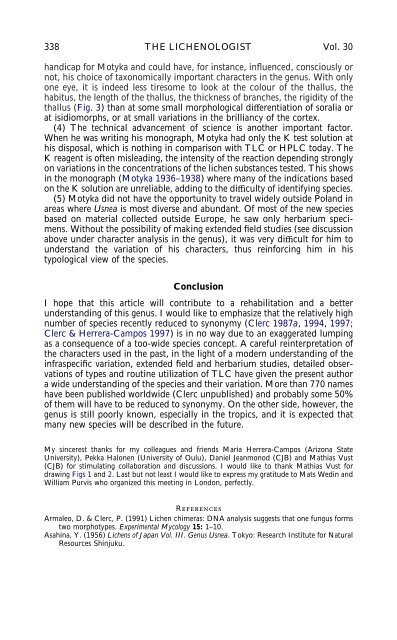SPECIES CONCEPTS IN THE GENUS USNEA (LICHENIZED ...
SPECIES CONCEPTS IN THE GENUS USNEA (LICHENIZED ...
SPECIES CONCEPTS IN THE GENUS USNEA (LICHENIZED ...
Create successful ePaper yourself
Turn your PDF publications into a flip-book with our unique Google optimized e-Paper software.
338 <strong>THE</strong> LICHENOLOGIST Vol. 30<br />
handicap for Motyka and could have, for instance, influenced, consciously or<br />
not, his choice of taxonomically important characters in the genus. With only<br />
one eye, it is indeed less tiresome to look at the colour of the thallus, the<br />
habitus, the length of the thallus, the thickness of branches, the rigidity of the<br />
thallus (Fig. 3) than at some small morphological differentiation of soralia or<br />
at isidiomorphs, or at small variations in the brilliancy of the cortex.<br />
(4) The technical advancement of science is another important factor.<br />
When he was writing his monograph, Motyka had only the K test solution at<br />
his disposal, which is nothing in comparison with TLC or HPLC today. The<br />
K reagent is often misleading, the intensity of the reaction depending strongly<br />
on variations in the concentrations of the lichen substances tested. This shows<br />
in the monograph (Motyka 1936–1938) where many of the indications based<br />
on the K solution are unreliable, adding to the difficulty of identifying species.<br />
(5) Motyka did not have the opportunity to travel widely outside Poland in<br />
areas where Usnea is most diverse and abundant. Of most of the new species<br />
based on material collected outside Europe, he saw only herbarium specimens.<br />
Without the possibility of making extended field studies (see discussion<br />
above under character analysis in the genus), it was very difficult for him to<br />
understand the variation of his characters, thus reinforcing him in his<br />
typological view of the species.<br />
Conclusion<br />
I hope that this article will contribute to a rehabilitation and a better<br />
understanding of this genus. I would like to emphasize that the relatively high<br />
number of species recently reduced to synonymy (Clerc 1987a, 1994, 1997;<br />
Clerc & Herrera-Campos 1997) is in no way due to an exaggerated lumping<br />
as a consequence of a too-wide species concept. A careful reinterpretation of<br />
the characters used in the past, in the light of a modern understanding of the<br />
infraspecific variation, extended field and herbarium studies, detailed observations<br />
of types and routine utilization of TLC have given the present author<br />
a wide understanding of the species and their variation. More than 770 names<br />
have been published worldwide (Clerc unpublished) and probably some 50%<br />
of them will have to be reduced to synonymy. On the other side, however, the<br />
genus is still poorly known, especially in the tropics, and it is expected that<br />
many new species will be described in the future.<br />
My sincerest thanks for my colleagues and friends Maria Herrera-Campos (Arizona State<br />
University), Pekka Halonen (University of Oulu), Daniel Jeanmonod (CJB) and Mathias Vust<br />
(CJB) for stimulating collaboration and discussions. I would like to thank Mathias Vust for<br />
drawing Figs 1 and 2. Last but not least I would like to express my gratitude to Mats Wedin and<br />
William Purvis who organized this meeting in London, perfectly.<br />
References<br />
Armaleo, D. & Clerc, P. (1991) Lichen chimeras: DNA analysis suggests that one fungus forms<br />
two morphotypes. Experimental Mycology 15: 1–10.<br />
Asahina, Y. (1956) Lichens of Japan Vol. III. Genus Usnea. Tokyo: Research Institute for Natural<br />
Resources Shinjuku.

















